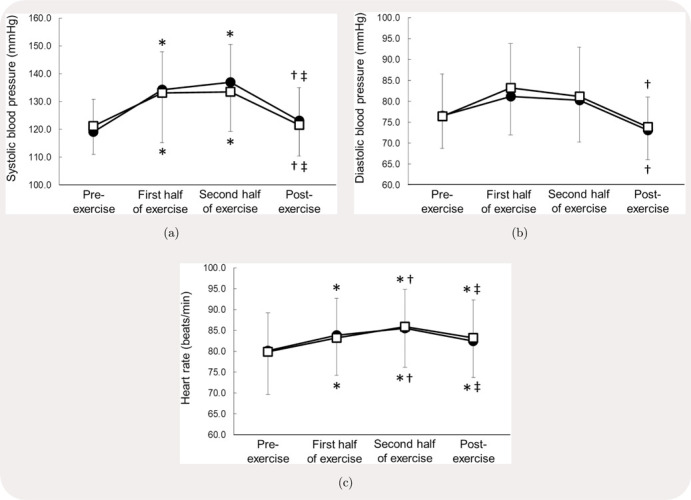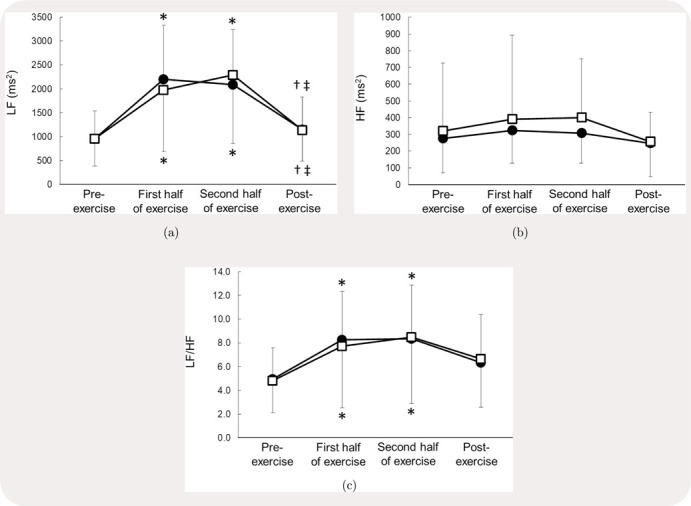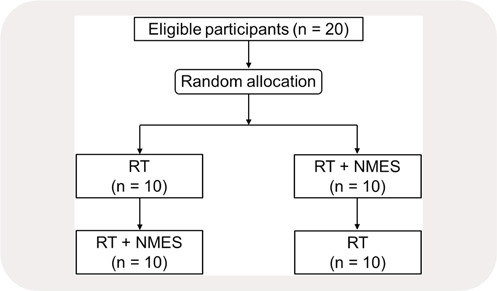低强度抗阻训练联合神经肌肉电刺激对健康成人自主神经活动的影响:一项随机对照交叉试验
IF 1
Q4 REHABILITATION
Hong Kong Physiotherapy Journal
Pub Date : 2021-06-01
Epub Date: 2020-09-30
DOI:10.1142/S1013702521500013
引用次数: 1
摘要
背景:低强度阻力训练(RT)联合神经肌肉电刺激(NMES)是改善身体功能衰退的一种运动方法。然而,目前尚不清楚低强度放疗联合NMES (RT + NMES)是否可以安全实施。目的:探讨低强度RT + NMES对健康成人自主神经活动和心血管反应的影响。方法:本研究为开放标签、随机对照交叉试验。等距膝关节伸展RT的运动强度设定为最大自主收缩(峰值扭矩)的40%。将NMES调整为双相不对称波形,保持频率为50 Hz,相持续时间为300 μ s,通过测量RT和RT + NMES期间的心率变异性、血压和心率,比较自主神经活动和心血管反应的变化差异。0±0。6岁)参加了本研究。在RT和RT + NMES阶段,心率变异性、收缩压和心率的低频和高频成分的比例在运动期间增加(P < 0.05)。在整个RT和RT + NMES过程中,自主神经活动和心血管反应没有显著差异。结论:我们的研究结果表明,低强度RT + NMES是安全的,不会诱导健康成人过度的自主神经和心血管反应。本文章由计算机程序翻译,如有差异,请以英文原文为准。



The influence of low-intensity resistance training combined with neuromuscular electrical stimulation on autonomic activity in healthy adults: A randomized controlled cross-over trial.
Background: Low-intensity resistance training (RT) combined with neuromuscular electrical stimulation (NMES) is one method of exercise to improve the deterioration of physical function. However, it is unclear whether low-intensity RT combined with NMES (RT + NMES) can be safely implemented. Objective: This study aimed to examine the influence of low-intensity RT + NMES on autonomic activity and cardiovascular responses in healthy adults. Methods: This study was an open-label, randomized controlled cross-over trial. The exercise intensity of isometric knee extension RT was set to 40% of the maximum voluntary contraction (peak torque). NMES was adjusted to a biphasic asymmetrical waveform with the frequency maintained at 50 Hz and a phase duration of 300 μs. The difference in the change in autonomic activity and cardiovascular responses was compared by assessing heart rate variability, blood pressure, and heart rate during RT and RT+NMES. Results: Twenty healthy male college students (mean age 21.0±0.6 years) participated in this study. The ratio of low- and high-frequency components of heart rate variability, systolic blood pressure, and heart rate increased during exercise in the RT and RT+NMES sessions (P<0.05). There were no significant differences in autonomic activity and cardiovascular responses throughout the sessions during RT and RT+NMES. Conclusion: In conclusion, our results demonstrated that low-intensity RT+NMES was safe and did not induce excessive autonomic and cardiovascular responses in healthy adults.
求助全文
通过发布文献求助,成功后即可免费获取论文全文。
去求助
来源期刊

Hong Kong Physiotherapy Journal
REHABILITATION-
CiteScore
2.30
自引率
6.70%
发文量
13
审稿时长
24 weeks
期刊介绍:
The Hong Kong Physiotherapy Journal is the official journal of the Hong Kong Physiotherapy Association Limited (HKPA Ltd). This peer-reviewed journal aims to contribute to and document the advancements in the principles and practice of physiotherapy in Hong Kong.The Hong Kong Physiotherapy Journal is published annually and papers are categorized into research reports, treatment reports, technical reports, literature reviews, and letters to the editor.
 求助内容:
求助内容: 应助结果提醒方式:
应助结果提醒方式:


